spare wheel DODGE CHALLENGER SRT 2019 Vehicle Warranty
[x] Cancel search | Manufacturer: DODGE, Model Year: 2019, Model line: CHALLENGER SRT, Model: DODGE CHALLENGER SRT 2019Pages: 270, PDF Size: 2.52 MB
Page 57 of 270
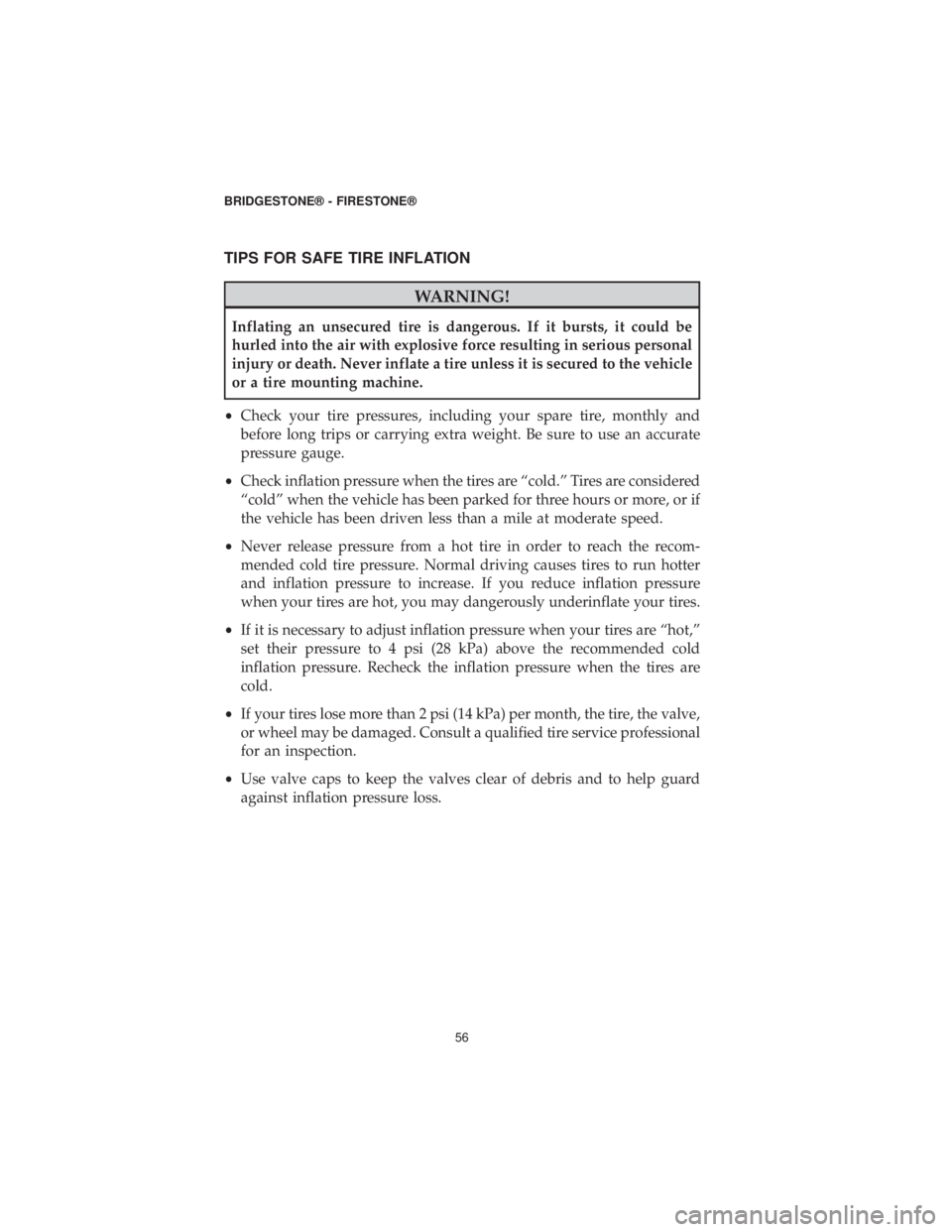
TIPS FOR SAFE TIRE INFLATION
WARNING!
Inflating an unsecured tire is dangerous. If it bursts, it could be
hurled into the air with explosive force resulting in serious personal
injury or death. Never inflate a tire unless it is secured to the vehicle
or a tire mounting machine.
• Check your tire pressures, including your spare tire, monthly and
before long trips or carrying extra weight. Be sure to use an accurate
pressure gauge.
• Check inflation pressure when the tires are “cold.” Tires are considered
“cold” when the vehicle has been parked for three hours or more, or if
the vehicle has been driven less than a mile at moderate speed.
• Never release pressure from a hot tire in order to reach the recom-
mended cold tire pressure. Normal driving causes tires to run hotter
and inflation pressure to increase. If you reduce inflation pressure
when your tires are hot, you may dangerously underinflate your tires.
• If it is necessary to adjust inflation pressure when your tires are “hot,”
set their pressure to 4 psi (28 kPa) above the recommended cold
inflation pressure. Recheck the inflation pressure when the tires are
cold.
• If your tires lose more than 2 psi (14 kPa) per month, the tire, the valve,
or wheel may be damaged. Consult a qualified tire service professional
for an inspection.
• Use valve caps to keep the valves clear of debris and to help guard
against inflation pressure loss.
BRIDGESTONE® - FIRESTONE®
56
Page 59 of 270
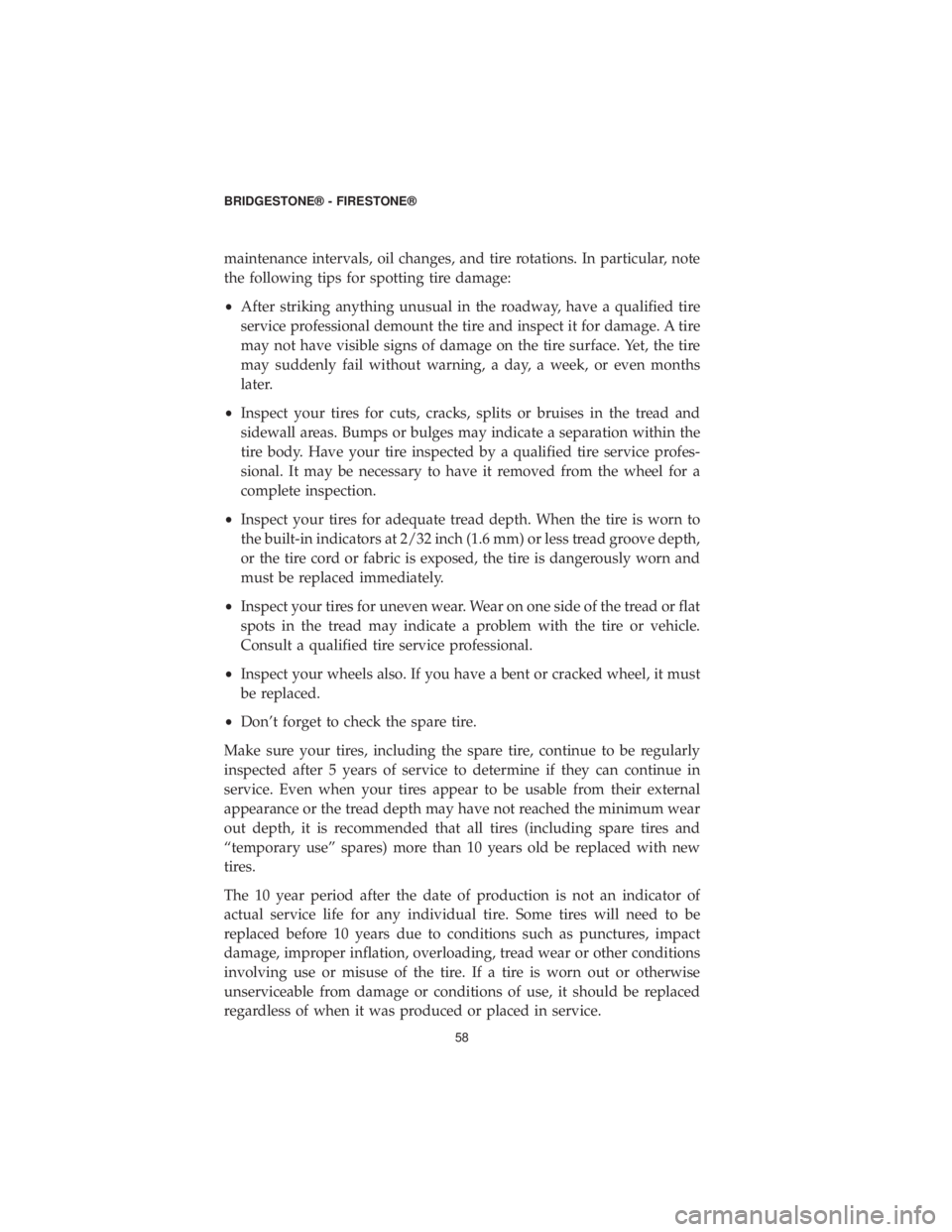
maintenance intervals, oil changes, and tire rotations. In particular, note
the following tips for spotting tire damage:
•After striking anything unusual in the roadway, have a qualified tire
service professional demount the tire and inspect it for damage. A tire
may not have visible signs of damage on the tire surface. Yet, the tire
may suddenly fail without warning, a day, a week, or even months
later.
• Inspect your tires for cuts, cracks, splits or bruises in the tread and
sidewall areas. Bumps or bulges may indicate a separation within the
tire body. Have your tire inspected by a qualified tire service profes-
sional. It may be necessary to have it removed from the wheel for a
complete inspection.
• Inspect your tires for adequate tread depth. When the tire is worn to
the built-in indicators at 2/32 inch (1.6 mm) or less tread groove depth,
or the tire cord or fabric is exposed, the tire is dangerously worn and
must be replaced immediately.
• Inspect your tires for uneven wear. Wear on one side of the tread or flat
spots in the tread may indicate a problem with the tire or vehicle.
Consult a qualified tire service professional.
• Inspect your wheels also. If you have a bent or cracked wheel, it must
be replaced.
• Don’t forget to check the spare tire.
Make sure your tires, including the spare tire, continue to be regularly
inspected after 5 years of service to determine if they can continue in
service. Even when your tires appear to be usable from their external
appearance or the tread depth may have not reached the minimum wear
out depth, it is recommended that all tires (including spare tires and
“temporary use” spares) more than 10 years old be replaced with new
tires.
The 10 year period after the date of production is not an indicator of
actual service life for any individual tire. Some tires will need to be
replaced before 10 years due to conditions such as punctures, impact
damage, improper inflation, overloading, tread wear or other conditions
involving use or misuse of the tire. If a tire is worn out or otherwise
unserviceable from damage or conditions of use, it should be replaced
regardless of when it was produced or placed in service.
BRIDGESTONE® - FIRESTONE®
58
Page 70 of 270
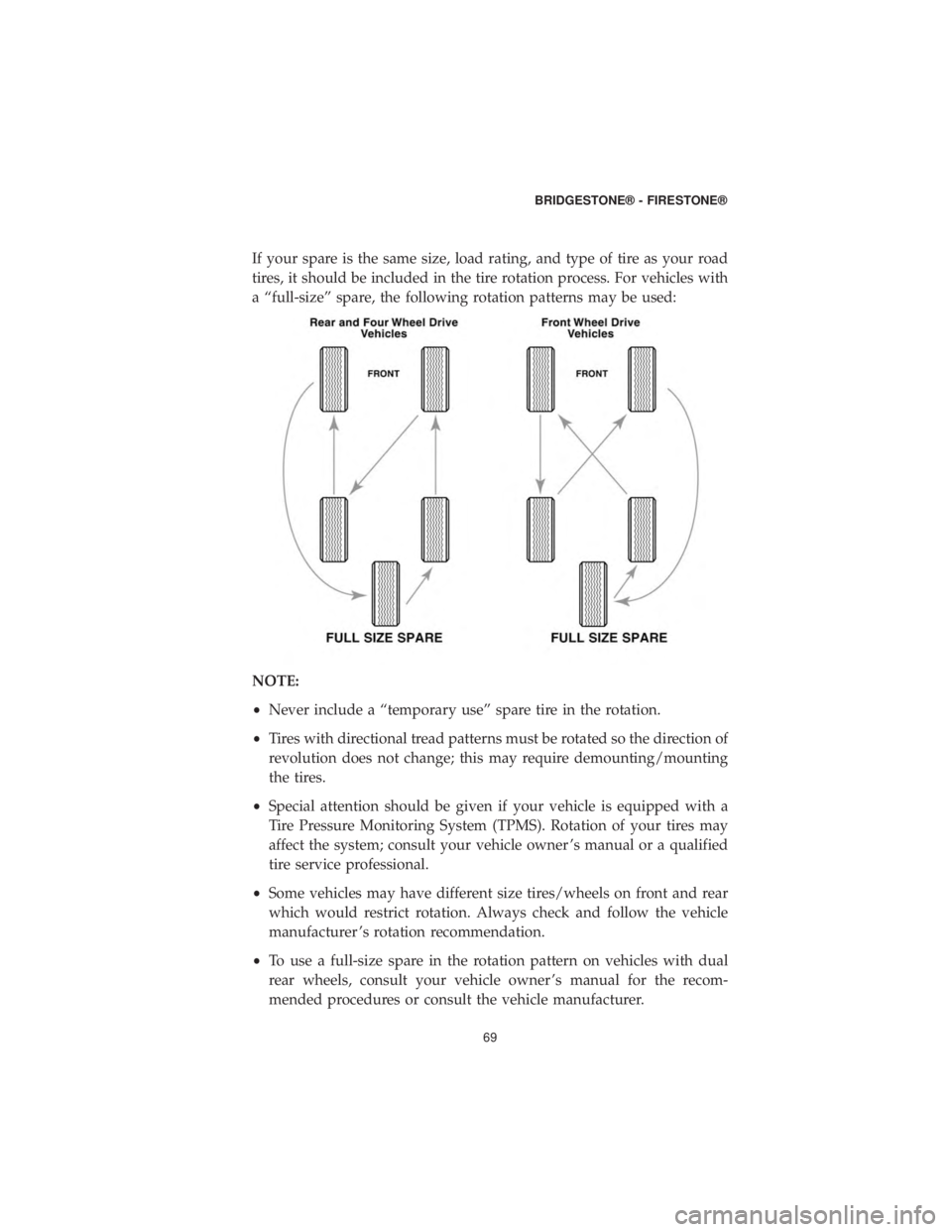
If your spare is the same size, load rating, and type of tire as your road
tires, it should be included in the tire rotation process. For vehicles with
a “full-size” spare, the following rotation patterns may be used:
NOTE:
•Never include a “temporary use” spare tire in the rotation.
• Tires with directional tread patterns must be rotated so the direction of
revolution does not change; this may require demounting/mounting
the tires.
• Special attention should be given if your vehicle is equipped with a
Tire Pressure Monitoring System (TPMS). Rotation of your tires may
affect the system; consult your vehicle owner ’s manual or a qualified
tire service professional.
• Some vehicles may have different size tires/wheels on front and rear
which would restrict rotation. Always check and follow the vehicle
manufacturer ’s rotation recommendation.
• To use a full-size spare in the rotation pattern on vehicles with dual
rear wheels, consult your vehicle owner ’s manual for the recom-
mended procedures or consult the vehicle manufacturer.
BRIDGESTONE® - FIRESTONE®
69
Page 71 of 270
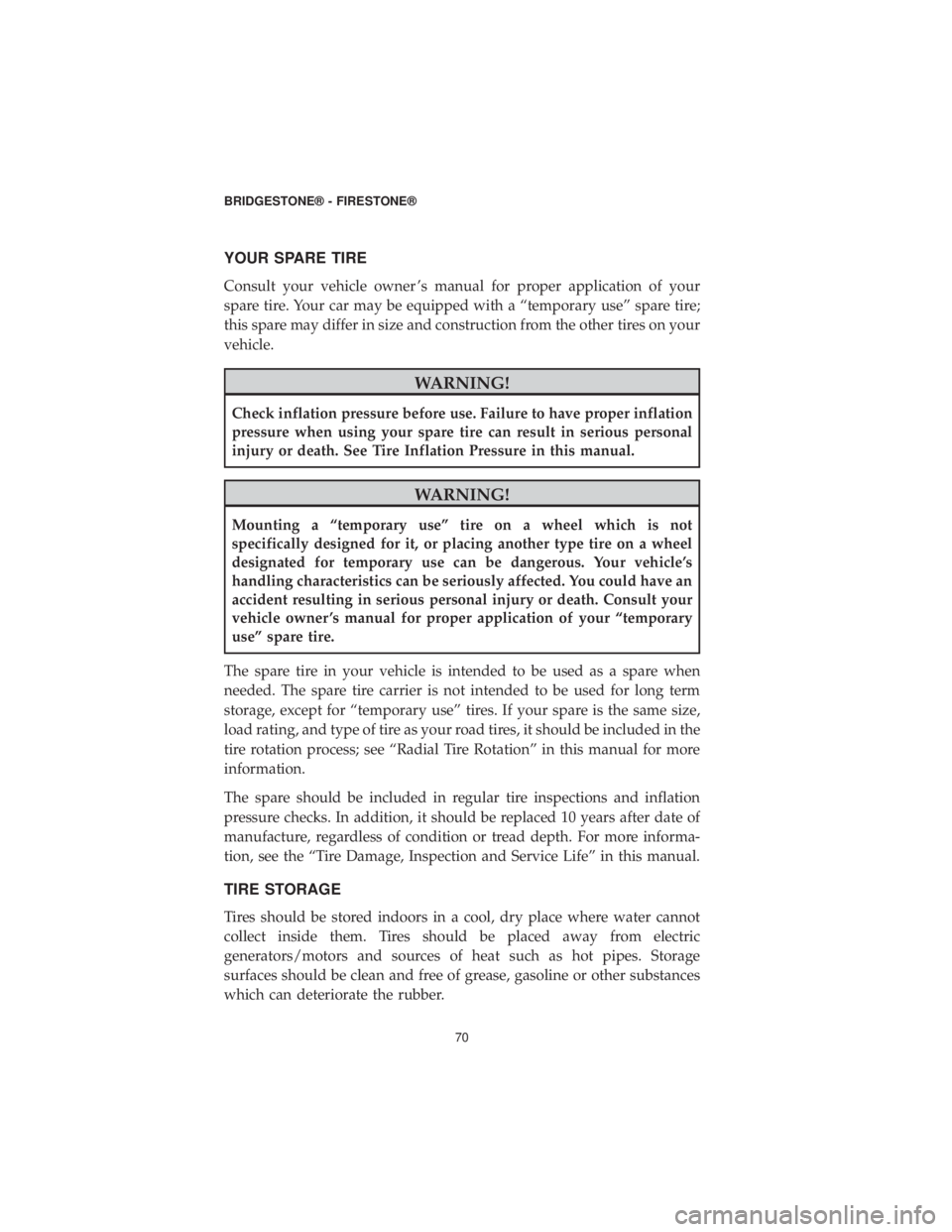
YOUR SPARE TIRE
Consult your vehicle owner ’s manual for proper application of your
spare tire. Your car may be equipped with a “temporary use” spare tire;
this spare may differ in size and construction from the other tires on your
vehicle.
WARNING!
Check inflation pressure before use. Failure to have proper inflation
pressure when using your spare tire can result in serious personal
injury or death. See Tire Inflation Pressure in this manual.
WARNING!
Mounting a “temporary use” tire on a wheel which is not
specifically designed for it, or placing another type tire on a wheel
designated for temporary use can be dangerous. Your vehicle’s
handling characteristics can be seriously affected. You could have an
accident resulting in serious personal injury or death. Consult your
vehicle owner ’s manual for proper application of your “temporary
use” spare tire.
The spare tire in your vehicle is intended to be used as a spare when
needed. The spare tire carrier is not intended to be used for long term
storage, except for “temporary use” tires. If your spare is the same size,
load rating, and type of tire as your road tires, it should be included in the
tire rotation process; see “Radial Tire Rotation” in this manual for more
information.
The spare should be included in regular tire inspections and inflation
pressure checks. In addition, it should be replaced 10 years after date of
manufacture, regardless of condition or tread depth. For more informa-
tion, see the “Tire Damage, Inspection and Service Life” in this manual.
TIRE STORAGE
Tires should be stored indoors in a cool, dry place where water cannot
collect inside them. Tires should be placed away from electric
generators/motors and sources of heat such as hot pipes. Storage
surfaces should be clean and free of grease, gasoline or other substances
which can deteriorate the rubber.
BRIDGESTONE® - FIRESTONE®
70
Page 73 of 270
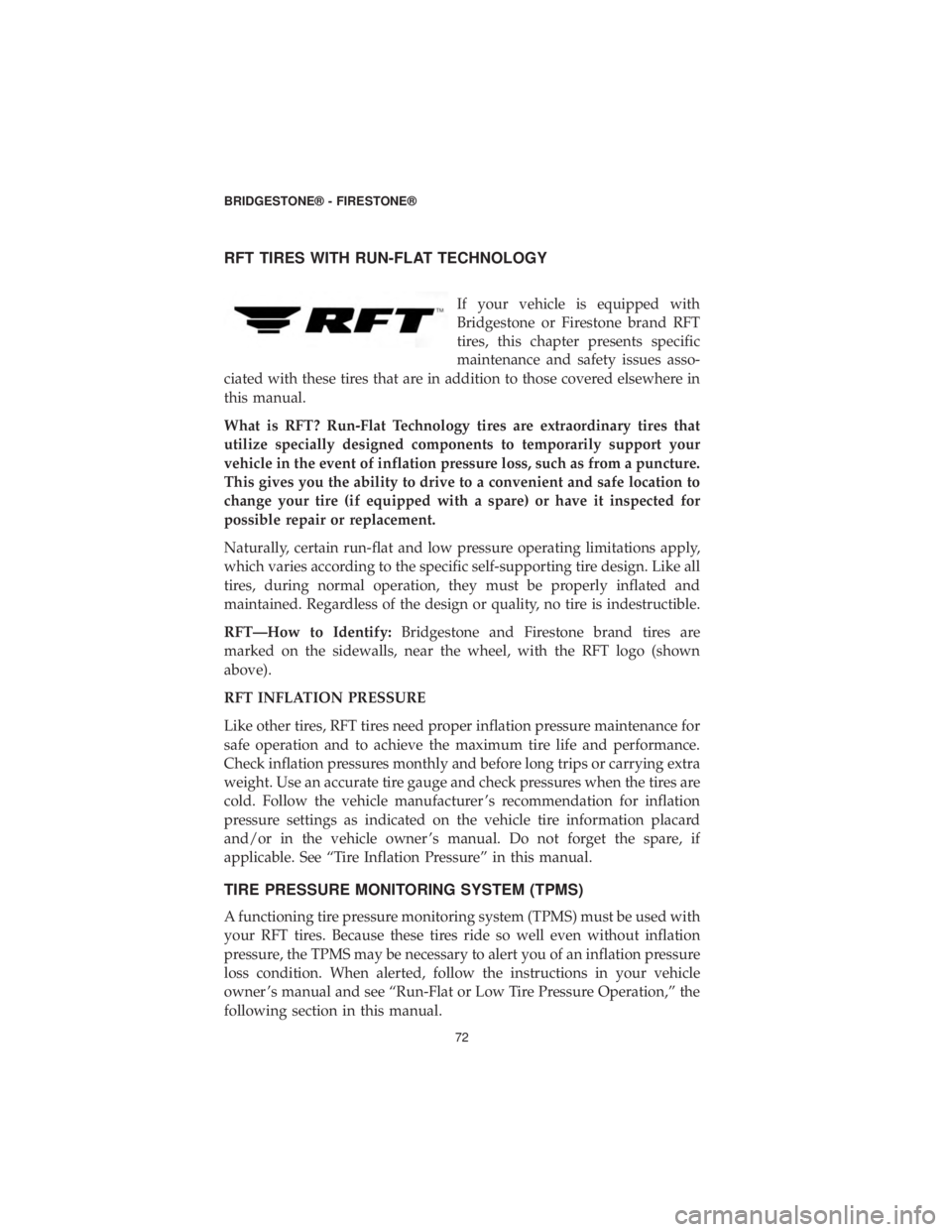
RFT TIRES WITH RUN-FLAT TECHNOLOGY
If your vehicle is equipped with
Bridgestone or Firestone brand RFT
tires, this chapter presents specific
maintenance and safety issues asso-
ciated with these tires that are in addition to those covered elsewhere in
this manual.
What is RFT? Run-Flat Technology tires are extraordinary tires that
utilize specially designed components to temporarily support your
vehicle in the event of inflation pressure loss, such as from a puncture.
This gives you the ability to drive to a convenient and safe location to
change your tire (if equipped with a spare) or have it inspected for
possible repair or replacement.
Naturally, certain run-flat and low pressure operating limitations apply,
which varies according to the specific self-supporting tire design. Like all
tires, during normal operation, they must be properly inflated and
maintained. Regardless of the design or quality, no tire is indestructible.
RFT—How to Identify: Bridgestone and Firestone brand tires are
marked on the sidewalls, near the wheel, with the RFT logo (shown
above).
RFT INFLATION PRESSURE
Like other tires, RFT tires need proper inflation pressure maintenance for
safe operation and to achieve the maximum tire life and performance.
Check inflation pressures monthly and before long trips or carrying extra
weight. Use an accurate tire gauge and check pressures when the tires are
cold. Follow the vehicle manufacturer ’s recommendation for inflation
pressure settings as indicated on the vehicle tire information placard
and/or in the vehicle owner ’s manual. Do not forget the spare, if
applicable. See “Tire Inflation Pressure” in this manual.
TIRE PRESSURE MONITORING SYSTEM (TPMS)
A functioning tire pressure monitoring system (TPMS) must be used with
your RFT tires. Because these tires ride so well even without inflation
pressure, the TPMS may be necessary to alert you of an inflation pressure
loss condition. When alerted, follow the instructions in your vehicle
owner ’s manual and see “Run-Flat or Low Tire Pressure Operation,” the
following section in this manual.
BRIDGESTONE® - FIRESTONE®
72
Page 99 of 270

ROTATION AND WEAR
Falken recommends rotating your tires at least every 8,000 km (5,000
miles) and periodically inspecting your tires to make sure they are free of
road hazards (such as nails, screws, large wood splinters, etc.) that might
penetrate your tires causing them to lose air pressure and to ensure they
are wearing evenly. Common irregular wear patterns are: misalignment
wear, where the tire shows excessive outer or inner tread wear. Tire
sidewalls should also be inspected for cuts, snags, bruises, and weather
cracking. If any of these noted conditions are present during inspection,
we recommend returning to your servicing tire dealer to be corrected to
ensure long tire life.***Never include a temporary spare tire in your
rotation pattern***
TIRE REPLACEMENT
Falken recommends replacing your tires when the tread wears down to
the wear bars at 1.6 mm (2/32 of an inch), which are located across the
tread in several locations around the tire. If only two tires are being
replaced, the two new tires should always be installed on the rear of the
vehicle to aid in preventing your vehicle from hydroplaning, even if your
car is front wheel drive. It’s always recommended to have your new tires
balanced during installation, and alignment checked if the previous tires
show and irregular wear. Tires that have been in use for 5 (five) years or
more should continue to be inspected by a qualified tire specialist, at least
annually. It is recommended that any tires 10 (ten) years old or older from
the date of manufacture, including spare tires, be replaced with new tires
as a precaution even if such tires appear serviceable and even if they have
not reached the legal worn out limit at 1.6 mm (2/32 of an inch).
FALKEN TIRE CORPORATION
98
Page 100 of 270
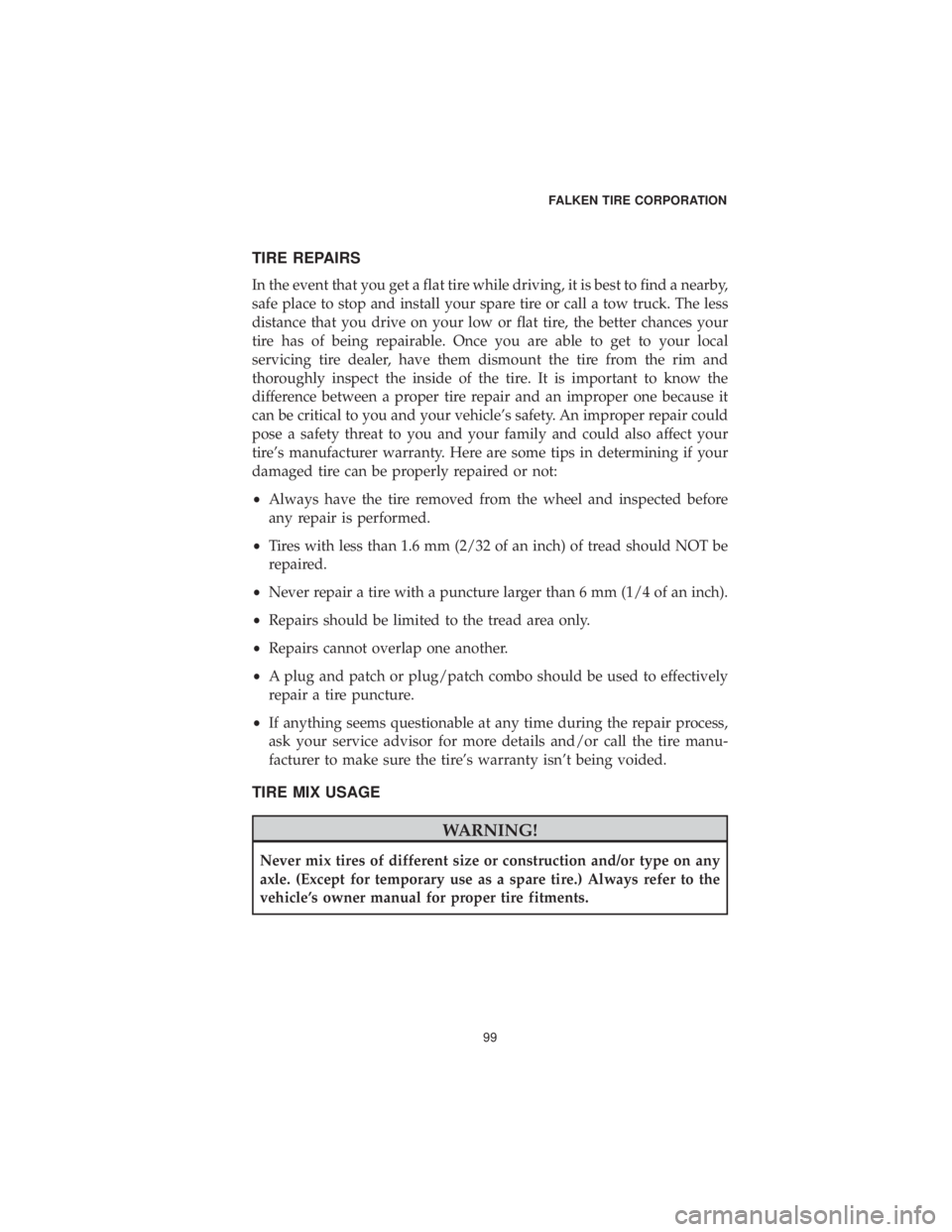
TIRE REPAIRS
In the event that you get a flat tire while driving, it is best to find a nearby,
safe place to stop and install your spare tire or call a tow truck. The less
distance that you drive on your low or flat tire, the better chances your
tire has of being repairable. Once you are able to get to your local
servicing tire dealer, have them dismount the tire from the rim and
thoroughly inspect the inside of the tire. It is important to know the
difference between a proper tire repair and an improper one because it
can be critical to you and your vehicle’s safety. An improper repair could
pose a safety threat to you and your family and could also affect your
tire’s manufacturer warranty. Here are some tips in determining if your
damaged tire can be properly repaired or not:
•Always have the tire removed from the wheel and inspected before
any repair is performed.
• Tires with less than 1.6 mm (2/32 of an inch) of tread should NOT be
repaired.
• Never repair a tire with a puncture larger than 6 mm (1/4 of an inch).
• Repairs should be limited to the tread area only.
• Repairs cannot overlap one another.
• A plug and patch or plug/patch combo should be used to effectively
repair a tire puncture.
• If anything seems questionable at any time during the repair process,
ask your service advisor for more details and/or call the tire manu-
facturer to make sure the tire’s warranty isn’t being voided.
TIRE MIX USAGE
WARNING!
Never mix tires of different size or construction and/or type on any
axle. (Except for temporary use as a spare tire.) Always refer to the
vehicle’s owner manual for proper tire fitments.
FALKEN TIRE CORPORATION
99
Page 132 of 270

Tire Pressure Monitoring System Alert
Refer to your vehicle Owner ’s Manual for more information on what to
do if the tire pressure warning system activates.
THE CONVENIENCE (TEMPORARY) SPARE
The Convenience (Temporary) Spare is designed, built and tested to the
high engineering standards set by North America’s leading car manufac-
turers and to Goodyear ’s own high standards of quality control. It is
designed to take up a minimum of storage space and, at the same time,
fulfill the function of a spare tire when needed. The spare is kept in its
storage space, fully inflated at 60 psi. To be sure it is always ready for use,
the air pressure should be checked on a regular basis.
The Convenience (Temporary) Spare can be used in combination with the
original tires on your vehicle. You can expect a tire tread life of up to 3,000
miles (4,800 kilometers), depending on road conditions and your driving
habits. To conserve tire tread life, return the spare to the storage area as
soon as it is convenient to have the standard tire repaired or replaced.
The Convenience (Temporary) Spare weighs less than a standard tire so
it’s easier to handle. It also helps reduce the total car weight, which
contributes to fuel economy. The wheels used with the Convenience
(Temporary) Spare are specifically designed for use with high pressure
spares and should never be used with any other type tire.
DON’T ATTEMPT TO MOUNT YOUR OWN TIRES
Serious injury or death may result from explosion of tire/rim assembly
due to improper mounting procedures. Follow tire manufacturer ’s
instructions and match tire diameter to rim diameter. Mount light truck
radials on rims approved for radial service. Do not apply bead sealer.
This can inhibit bead seating. Lubricate beads and tire rim (including
tube or flap) contact surfaces. Lock assembly on mounting machine or
place in safety cage. STAND BACK and never exceed 40 psi to seat beads.
Never use a volatile substance or a rubber “donut” (also known as a bead
expander or “O-Ring”) to aid bead seating. Only specially trained
persons should mount tires.
GOODYEAR DUNLOP TIRES
131
Page 143 of 270

and beads. Do not exceed the maximum recommended pressure to
seat beads on rim. Use remote control inflation equipment and
inflation cage.
NOTE:
• Never inflate over 40 psi to seat beads.
• Mount radial ply tires only on rims designated by wheel manufacturer
as suitable for radial tire.
• Only specially trained persons shall mount tires.
• AIR PRESSURE
Check the pressure in your tires, including your spare, at least
monthly, and always before and during extended driving. Check tires
cold (at least 3 hours after the vehicle has been stopped and before it
is driven more than 1.6 kilometers or 1 mile). Do not reduce pressure
when tires are hot, use an accurate air pressure gauge to check
pressure and maintain it at the level recommended on the vehicle tire
placard or in the Owner ’s Manual. Under inflation produces extreme
flexing of sidewalls and builds up heat to the point that premature tire
failure may occur. Over inflation can cause the tires to be more
susceptible to impact damage. Cold tire pressures, however, should
never be higher than the limit molded on the sidewall.
• LOAD LIMITS
Never exceed the load-carrying limits molded onto the sidewall of
your tires or the maximum vehicle load limit as shown on the vehicle
tire placard, whichever is less. Overloading builds up excessive heat in
the tire and leads to early and/or sudden failure.
• HAZARDS
Avoid running over objects (e.g., chuckholes, rocks, curbs, metal, glass,
etc.) which may possibly cause internal tire damage. Continued use of
a tire that has suffered internal damage (which may not be externally
visible) can lead to dangerous tire failure. Determination of suspected
internal damage requires demounting the tire from its rim and
examination by trained tire personnel.
HANKOOK TIRES
142
Page 145 of 270

•ADDITIONAL SAFETY INFORMATION FOR TEMPORARY TIRE
– Air pressure.
Check inflation pressure as soon as practical after installation and
inflate to 60 psi. The tire pressure should be checked monthly and
maintained at 60 psi while the tire is stored or in service.
– Vehicle restriction.
The temporary spare tire was specifically designed for your car and
should not be used on any other vehicle.
– Other restrictions.
The temporary spare tire should not be used with other wheels, nor
should standard tires, snow tires, wheel covers, or trim rings be used
with the temporary spare wheel. If such use is attempted, damage to
these items or other vehicle components may occur.
TIRE SERVICE ASSISTANCE OR INFORMATION
When you have tire problems, Hankook provides service and assistance.
Any time you see damage to your tires, contact your local Hankook Tire
Dealer.
If no local dealer is available around you, dial Hankook Toll Free Service
Number so that you can get information on where and how service is
rendered to you.
FOR SERVICE ASSISTANCE OR INFORMATION
U.S.A.
CORPORATE HEADQUARTERS
1450 Valley Road, Wayne, New Jersey 07470 1–973-633-9000 Toll Free1–877-740-7000
WEST REGIONAL OFFICE
11555 Arrow Route, Suite 105, Rancho Cucamonga, CA 91730 1–909-481-9800 Toll Free1–800-426-8252
CANADA
CORPORATE HEADQUARTERS
30 Resolution Dr., Brampton, Ontario L6W 0A3 1–905-463-9802 Toll Free1–800-843-7709
HANKOOK TIRES
144